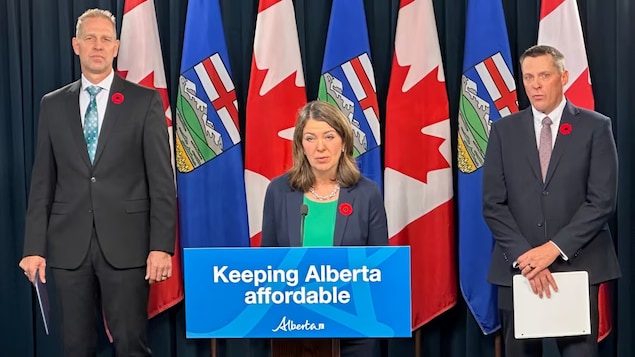- Home
- Politics
The unravelling of Danielle Smith’s case for Alberta’s renewables pause

La première ministre de l'Alberta, Danielle Smith (au centre) a annoncé des plans à court et à long termes pour réformer l'assurance automobile en Alberta, à l'Assemblée législative, le 1er novembre 2023. Elle est entourée, à gauche, du ministre des Services publics, Nathan Neudorf, et du ministre des Finances, Nate Horner, à droite.
Photo: Radio-Canada / Dave Bajer/CBC
Alberta Premier Danielle Smith announced new rules governing renewable energy projects on Feb. 28 as the seven-month moratorium on renewables was about to end.
If there was any doubt remaining that Alberta's nearly seven-month moratorium on renewable-energy projects (new window) was a political decision — made in the halls of power rather than in the offices of expertise — it was erased by internal documents released to the public last week.
As first reported by The Narwhal (new window), which obtained the documents under a freedom-of-information request, the CEO of the independent Alberta Electric System Operator (AESO) was actually opposed to the moratorium. In internal communications, Mike Law said it would send a closed-for-business message
and could drive renewable-energy investments into a tailspin.
This, of course, flies in the face of Premier Danielle Smith's long-standing justification for the controversial policy, which has introduced all sorts of uncertainty into the province's once-bustling market for renewable-energy investment.
After announcing the moratorium last August, Smith claimed the Alberta Electric System Operator asked for us to do a pause to make sure that we could address issues of stability of the grid.
In support of her claim, she pointed to a published letter (new window) from the AESO CEO to Utilities Minister Nathan Neudorf — even though the letter said nothing of the sort (new window).
The internal documents now show the opposite chain of events: rather than the AESO asking the government for the pause, it was the government that asked the AESO to write a letter in support of the policy.
As you can imagine, [CEO] Mike [Law] is not comfortable with this but he has agreed to provide the letter,
AESO board chair Karl Johannson wrote in an email to fellow board members in July 2023.
I told him to support the minister without reservation.
Seeing these contradictions spelled out in black and white may have made a splash in the news cycle, but it didn't come as much of a surprise to those in the renewable-energy industry, who have long seen Alberta's official justifications for the moratorium — which lifted in March — as divorced from reality. Besides, they say, they now have larger concerns with new restrictions on renewable projects and a looming redesign of the electricity market.
Policy experts, meanwhile, say they have serious concerns about how the provincial government misled the public as to the origin and reasons for the seven-month pause, which was accompanied by a parallel inquiry into the impacts of renewable-energy projects (new window). They also worry about how this may affect future decisions surrounding — and investment in — Alberta's electricity market.
And there's plenty coming down the pike on both those fronts.
'We knew this early on'
Vittoria Bellissimo, president and CEO of the Canadian Renewable Energy Association, says many in the industry have believed for some time that the premier's explanation for the moratorium didn't stand up to scrutiny.
The Narwhal article was certainly very interesting but it wasn't news to industry,
she said.
Smith's additional claim that the Alberta Utilities Commission (AUC) had also asked for the moratorium has been debunked (new window), as well. And her assertion that the Rural Municipalities of Alberta (RMA) passed a motion requesting the pause has been denied by the RMA, itself (new window).
None of this surprised the industry.
Alberta's electricity sector is fairly small and it was generally understood by most participants and stakeholders that the pause on AUC approvals had not actually been requested by the Alberta Utilities Commission, itself, or by the Alberta Electric System Operator, or by the Rural Municipalities of Alberta,
Bellissimo said.
We knew this early on.
The industry and its financiers aren't naive, says Thomas Timmins, a Toronto-based lawyer with the firm Gowling WLG who serves clients in renewable-energy project development.
You'll see governments at the political level reaching down and interfering in energy and other policy matters frequently pretty much wherever you go,
he said.
And so when those emails get exposed … that always creates unease, but that's no surprise for these senior, experienced, hard-weathered people who operate in this industry.
There's nothing legally improper with the Alberta government giving direction to the system operator, according to University of Calgary law professor emeritus Nigel Bankes. The AESO was created through provincial legislation, he noted, and its status as an independent
operator refers to it having no stake in the ownership of power generation or transmission.
It doesn't really mean independent from government,
he said.
But, he stressed, that's not to say the government's actions were appropriate.
'To me, it's just deliberate misrepresentation'
Bankes says it is now crystal clear
that the government misrepresented the origins of the renewables pause and what it had been told by the electric system operator.
To me, it's just deliberate misrepresentation of the advice received — and I'll put it as bluntly as that,
he said.
No doubt in my mind: it was a political decision, not an expert-driven decision.
The contradiction between the government's claims and what the AESO was saying internally risks eroding trust in Alberta's free-market electricity system, according to Sara Hastings-Simon, a University of Calgary professor in the department of earth, energy and environment and the School of Public Policy.
This competitive system only works if investors have trust in it,
she said.
She worries it can also skew the public's understanding of how the system works, which can affect future policy directions.
The more that, say, electricity becomes politicized in that way, you don't necessarily get the good kinds of discussions and decision-making that you want to have,
she said.
And there are some big decisions looming.
Market redesign and shelved projects
The renewable-energy pause and subsequent restrictions on wind and solar projects (new window) — including a new 35-kilometre buffer zone around pristine viewscapes
— have attracted much of the public attention lately, but industry insiders are also watching closely as Alberta mulls another major policy change.
The provincial government has also tasked the AESO with drafting some fundamental changes (new window) to the structure of the province's electricity market, itself.
That could include the introduction of a day-ahead market
that would allow power generators to offer their electricity for the next day's use, in contrast to the real-time market in which generators currently operate. This could help the system operator improve grid stability and reduce price volatility (new window) but, depending on the details, it could also create further complications for wind and solar generators (new window), who can't predict with certainty how much power their facilities will generate in 24 hours' time.
The province wants AESO to provide a detailed plan by this fall, with the aim of having the new rules take effect by 2027.
How that plays out and where it goes is very much of keen interest to parties who were building and developing projects on the basis of the status quo, before those announcements,
said Timmins.
They're very, very cautious investors, so they need to understand how their cash flow models are going to work.
Last week, TransAlta announced it was cancelling one wind-energy project near Cardston, Alta., due to the province's new restrictions on renewables, and putting three other renewable projects on hold (new window) because of uncertainty in the market.
Bellissimo expects more projects to be cancelled or shelved in the near future.
Nobody knows what their revenue streams will look like going forward, and nobody knows if they can get their generation to market,
she said. So it's very, very difficult to proceed with a project in this type of risk environment.
Sidesteps and next steps
Asked why she said the AESO had asked for the pause — in light of the internal communications published by The Narwhal showing its CEO was opposed to the idea — Premier Danielle Smith didn't directly answer the question.
Whatever they're suggesting, I would have to beg to differ,
the premier said.
My job is to make sure the power grid doesn't fail and, if solar and wind policy needs to be changed so that it can be integrated better with our system and we can bring on baseload power, that's my job to make sure we do.
For his part, the system operator's chief executive said he was simply doing his job.
After internal discussions, in keeping with our mandate, the AESO provided our independent advice to the Government of Alberta to help them make an informed decision, and once that decision was made, the AESO supported the policy direction of government,
Law said in an emailed statement to CBC News.
Despite the concerns he's heard from clients about the turmoil in Alberta, Timmins said he doesn't want to paint too gloomy a picture
of the future of renewable-energy investment in the province.
When Alberta compares itself to hundreds of other jurisdictions around the world, it still comes off quite favourably,
he said. It's still a great place to invest. It still has incredible engineering talent, incredible financial markets, incredible depth of capital.
Bellissimo agreed all is not lost for future investment, but said the future looks starkly different from the recent past. Alberta attracted 75 per cent of new development in renewable energy in Canada two years ago, she noted, and more than 90 per cent last year.
So we really were leading the country, but times are changing,
she said.
I think Alberta is losing its edge, and I think other jurisdictions will start to look much more attractive in the future.
Robson Fletcher (new window) · CBC News




